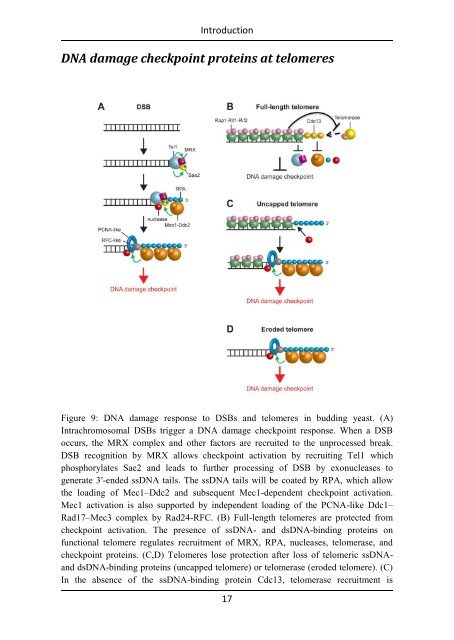View/Open - Università degli Studi di Milano-Bicocca
View/Open - Università degli Studi di Milano-Bicocca
View/Open - Università degli Studi di Milano-Bicocca
You also want an ePaper? Increase the reach of your titles
YUMPU automatically turns print PDFs into web optimized ePapers that Google loves.
Introduction<br />
DNA damage checkpoint proteins at telomeres<br />
Figure 9: DNA damage response to DSBs and telomeres in bud<strong>di</strong>ng yeast. (A)<br />
Intrachromosomal DSBs trigger a DNA damage checkpoint response. When a DSB<br />
occurs, the MRX complex and other factors are recruited to the unprocessed break.<br />
DSB recognition by MRX allows checkpoint activation by recruiting Tel1 which<br />
phosphorylates Sae2 and leads to further processing of DSB by exonucleases to<br />
generate 3′-ended ssDNA tails. The ssDNA tails will be coated by RPA, which allow<br />
the loa<strong>di</strong>ng of Mec1–Ddc2 and subsequent Mec1-dependent checkpoint activation.<br />
Mec1 activation is also supported by independent loa<strong>di</strong>ng of the PCNA-like Ddc1–<br />
Rad17–Mec3 complex by Rad24-RFC. (B) Full-length telomeres are protected from<br />
checkpoint activation. The presence of ssDNA- and dsDNA-bin<strong>di</strong>ng proteins on<br />
functional telomere regulates recruitment of MRX, RPA, nucleases, telomerase, and<br />
checkpoint proteins. (C,D) Telomeres lose protection after loss of telomeric ssDNA-<br />
and dsDNA-bin<strong>di</strong>ng proteins (uncapped telomere) or telomerase (eroded telomere). (C)<br />
In the absence of the ssDNA-bin<strong>di</strong>ng protein Cdc13, telomerase recruitment is<br />
17

















